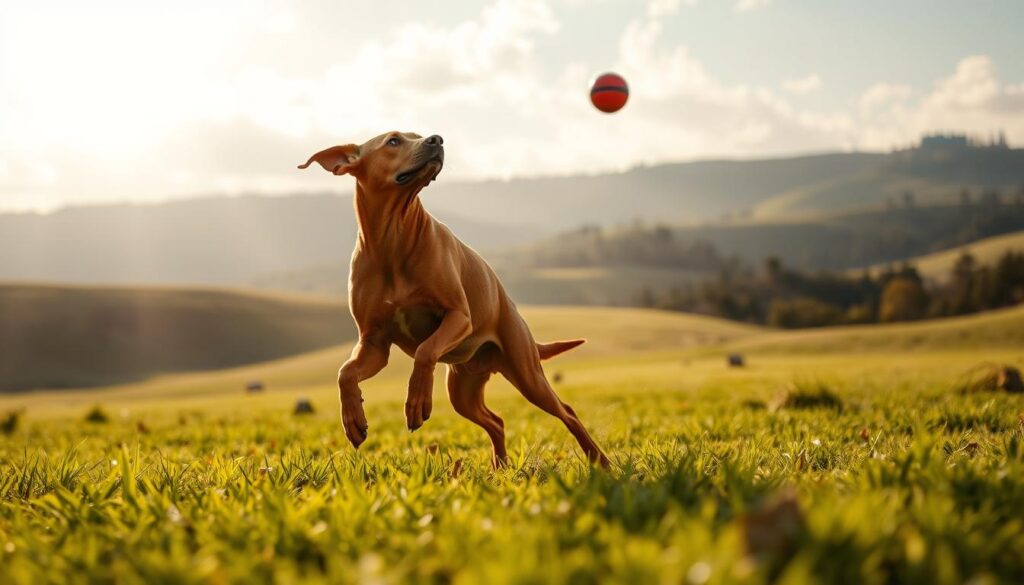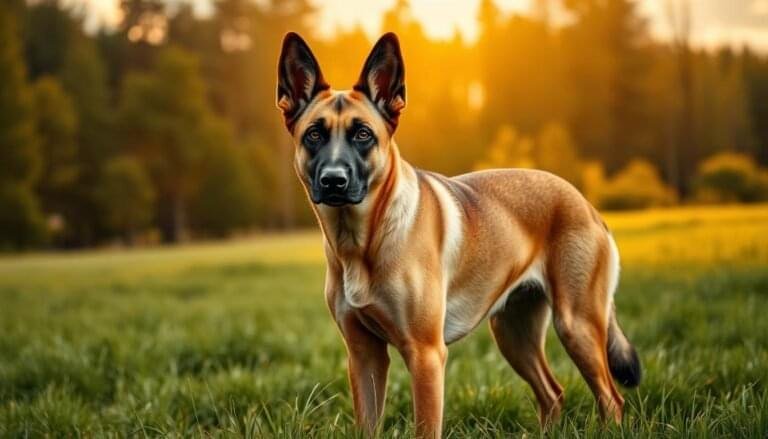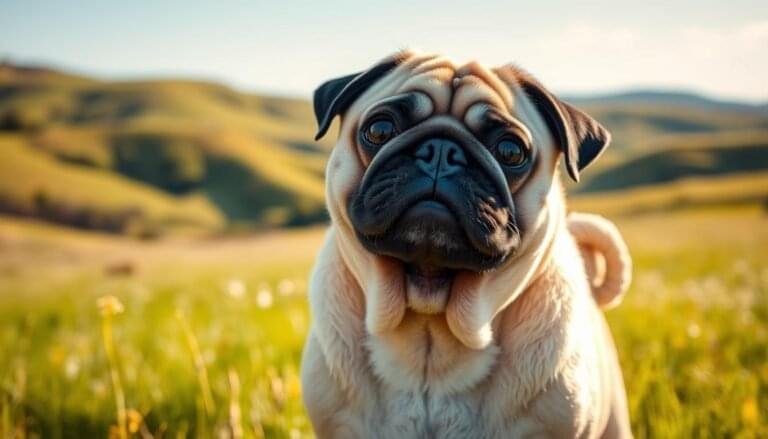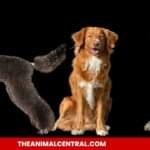Did you know a male Rhodesian Ridgeback can weigh up to 85 pounds? Yet, this African dog breed was bred to face lions. Despite their size, these “lion dogs” are dwarfed by lions, which weigh over seven times more. This shows the courage and tenacity of the Rhodesian Ridgeback, a breed with a fascinating history and unique characteristics.
I’m excited to explore this remarkable breed. The Rhodesian Ridgeback’s journey from Africa to worldwide recognition is inspiring. In 1955, both the American Kennel Club and the Federation Cynologique Internationale officially recognized the breed, marking a significant milestone in its history.
The Rhodesian Ridgeback’s story starts in the 16th century with the Khoekhoe people of South Africa. These indigenous people created a hunting companion that became the modern Rhodesian Ridgeback. Today, this breed is a testament to its African heritage, showing strength, intelligence, and loyalty in a striking package.
Key Takeaways
- Rhodesian Ridgebacks can weigh up to 85 pounds
- The breed was originally used to hunt lions
- Recognized by major kennel clubs in 1955
- Origins trace back to 16th century South Africa
- Developed by the indigenous Khoekhoe people
- Combines traits of strength, intelligence, and loyalty
Breed Overview
The Rhodesian Ridgeback is a unique dog breed with a rich history. It was bred for hunting and guarding. Here’s a quick snapshot of this fascinating breed in a table.
| Breed Attribute | Details |
|---|---|
| Origin | Bred in Rhodesia (now Zimbabwe) for lion hunting |
| Size | Males: 25-27 inches, 80-90 lbs; Females: 24-26 inches, 65-75 lbs |
| Lifespan | 10-12 years |
| Coat | Short, dense; shades of red and wheaten with distinctive ridge |
| Activity Level | High; requires daily long walks or jogs |
| Temperament | Independent, sometimes stubborn; not for novice owners |
| Health Concerns | Hip dysplasia, elbow dysplasia, bloat, eye problems |
| Grooming | Regular brushing to remove dead hair and prevent mats |
| Living Conditions | Adapts to apartments with exercise; ideal with large yard |
| Training | Needs consistent, firm approach; early training is key |
This powerful dog breed needs an active lifestyle and experienced handling. Rhodesian Ridgebacks are loyal guardians and versatile hunting companions. They are a unique choice for dedicated dog lovers.
History of the Rhodesian Ridgeback
The Rhodesian Ridgeback’s story starts in the 16th century. European explorers first met the Khoikhoi tribes in South Africa. These tribes had dogs with a unique ridge of hair along their backs.
Early Beginnings
The breeding of Ridgebacks began in the mid-1600s. Dutch settlers mixed their European dogs with the native Khoikhoi dogs. This mix created a breed perfect for Africa’s terrain.
Development in Africa
At first, Ridgebacks were bred for lion hunting. But they never actually hunted lions. Instead, they distracted and disoriented them.
In 1922, a meeting in Bulawayo showed the variety of Ridgebacks. This meeting led to the breed being officially named the Rhodesian Ridgeback.
Influence of Various Breeds
The Rhodesian Ridgeback today is a mix of South African native dogs and European breeds. These included dogs from Dutch, German, and Huguenot settlers. This mix gives the breed its unique traits.
| Year | Event |
|---|---|
| 1600s | Initial breeding begins |
| 1875 | First recorded use with settlers |
| 1922 | Breed officially named |
| 1924 | First Ridgebacks registered in South Africa |
| 1955 | AKC recognition |
Today, the Rhodesian Ridgeback is a symbol of its rich history. It combines the survival skills of African ancestors with European traits. This mix makes the ridged hound a versatile and cherished companion.
Characteristics of Rhodesian Ridgebacks
Rhodesian Ridgebacks are impressive dogs with distinct physical traits and unique personalities. Let’s explore the key features that make this breed stand out.
Physical Attributes
The Rhodesian Ridgeback is a large, muscular breed with a striking appearance. Males are 25 to 27 inches tall and weigh about 85 pounds. Females are slightly smaller, at 24 to 26 inches and about 70 pounds. Their most distinctive feature is the ridge on back, a strip of hair growing in the opposite direction along their spine.
These dogs have a short, dense coat that ranges from light wheaten to red wheaten. Their powerful build and athletic frame make them well-suited for various activities.
Temperament and Behavior
Rhodesian Ridgebacks are known for their loyal and affectionate nature. They form strong bonds with their families and are generally good with children. Despite their size, they have a gentle demeanor and are often described as quiet dogs.
| Characteristic | Rating |
|---|---|
| Affection Level | High |
| Friendliness | Medium |
| Kid-Friendly | High |
| Intelligence | High |
| Tendency to Bark | Low |
These intelligent dogs require mental stimulation and consistent training. While they can be independent thinkers, their loyalty makes them eager to please their owners. Rhodesian Ridgebacks have a strong protective instinct, making them excellent watchdogs.
The Ideal Family for a Ridgeback
Rhodesian Ridgebacks are amazing dogs that do well in the right family setting. They need a special mix of things to be happy as family pets.
Activity Level
Ridgebacks are very energetic and need an active family. They need daily exercise to stay happy and not get into trouble. A big, fenced yard is best, as they can jump over low fences.
Training Commitment
Training a Ridgeback takes a lot of work. They need weekly obedience classes and daily practice. About 90% of owners find it hard to train them, making early socialization very important.
Living Situations
Ridgebacks can live in different homes but need room to move. They are protective and good with kids if socialized right. Families should watch them closely, as they can be very big. They live for 10-12 years, sometimes up to 16.
| Aspect | Requirement |
|---|---|
| Exercise | High (daily) |
| Training | Intensive (weekly classes) |
| Space | Large (fenced yard) |
| Family Commitment | Long-term (10-16 years) |
Training Your Rhodesian Ridgeback
Training a Rhodesian Ridgeback needs patience and consistency. These dogs are smart and strong-willed, making them both fun and tough to train. They are bred to hunt and guard, so they need clear guidance to use their instincts well.
Basic Commands
Begin with short training sessions of 10-15 minutes, 2-3 times a day. Use simple, one-word commands like “sit,” “stay,” “down,” and “come.” Positive rewards like treats, praise, or playtime are important. Remember, every dog learns at their own speed, so be patient.
Advanced Training Techniques
When your Ridgeback gets better, add more complex tasks. Use different treats to keep them interested. If they do something wrong, teach them a better way to behave. For extra help, consider online training or professional trainers. Some online courses offer lifetime access and a money-back guarantee.
Socialization Tips
Early socialization is key for Rhodesian Ridgebacks. Introduce your puppy to different places, people, and animals. This helps prevent aggression, a common problem in untrained Ridgebacks. It’s important for all family members to use the same commands and rewards. With the right training, your Rhodesian Ridgeback will be a loyal and well-behaved friend.
Exercise Needs of the Rhodesian Ridgeback
The Rhodesian Ridgeback, an African dog breed, needs lots of physical activity. This keeps them healthy and happy. They must exercise regularly to keep their muscles strong and their energy levels high.
Daily Requirements
Rhodesian Ridgebacks need at least one to two hours of exercise every day. You can split this into two sessions. A longer walk or run in the morning and a shorter one in the evening is good. For puppies, the 5-minute rule is best: 5 minutes of exercise per month of age, up to twice daily.
Recommended Activities
These African dogs are great at many activities. They love to use their hunting instincts and physical skills. Here are some activities I recommend:
- Hiking trails
- Jogging with their owners
- Swimming (great for low-impact exercise)
- Fetch games in open spaces
- Agility training
Signs of Under-exercise
An under-exercised Rhodesian Ridgeback may show:
- Destructive behavior at home
- Excessive barking or whining
- Weight gain
- Restlessness or pacing
- Difficulty settling down
By giving them enough exercise, you’ll keep your Rhodesian Ridgeback healthy, happy, and well-behaved. Remember, each dog is different. Their needs depend on their age, health, and how active they are.
Grooming Your Rhodesian Ridgeback
Keeping your Rhodesian Ridgeback looking its best requires regular grooming. These dogs have a unique ridge on back that needs special attention. Let’s dive into the grooming routine for this majestic breed.
Brush Frequency
Rhodesian Ridgebacks are average shedders. I recommend brushing your dog weekly with a rubber brush or grooming mitt. This helps remove loose hair and keeps their coat healthy.
Bathing Routine
Rhodesians don’t need frequent baths. A monthly bath is usually enough, unless they get dirty. Use a gentle dog shampoo to clean their coat, paying extra attention to the ridge on their back.
Nail Care
Trim your Ridgeback’s nails twice a month. Many owners find using a Dremel tool more effective than nail clippers. If you hear clicking when your dog walks, it’s time for a trim.
| Grooming Task | Frequency |
|---|---|
| Brushing | Weekly |
| Bathing | Monthly |
| Nail Trimming | Twice a month |
| Ear Cleaning | Weekly |
| Teeth Brushing | Daily or every other day |
Remember to clean your Rhodesian’s ears weekly to prevent infections. Brush their teeth daily for optimal dental health. With proper care, your Ridgeback will stay healthy and handsome.
Health Considerations for Ridgebacks
Rhodesian Ridgebacks are generally healthy dogs. But, like any breed, they can face certain health issues. As a responsible owner, I stay informed and keep up with regular vet check-ups.
Common Health Issues
Ridgebacks can be prone to several conditions. Hip and elbow dysplasia are orthopedic issues common in large breeds. These can cause pain and arthritis if not treated.
Bloat, or gastric dilatation-volvulus, is another serious concern for deep-chested dogs like Ridgebacks.
- Hypothyroidism
- Degenerative myelopathy
- Heart diseases like dilated cardiomyopathy
- Various types of cancer
Regular Vet Visits
I take my Rhodesian Ridgeback for regular check-ups to catch any issues early. These visits include physical exams, blood tests, and screenings for breed-specific conditions. Early detection is key to managing health problems effectively.
Vaccination Importance
Keeping up with vaccinations is vital for preventing serious diseases. I work with my vet to create a vaccination schedule tailored to my dog’s needs and lifestyle. This protects my Ridgeback and other dogs we might meet during our outdoor adventures.
| Health Issue | Symptoms | Prevention/Management |
|---|---|---|
| Hip Dysplasia | Limping, stiffness | Regular exercise, weight control |
| Bloat | Swollen abdomen, restlessness | Multiple small meals, avoid exercise after eating |
| Hypothyroidism | Weight gain, hair loss | Annual thyroid screening |
Nutrition for Rhodesian Ridgebacks
Feeding your Rhodesian Ridgeback the right diet is key for their health. These African dogs, also known as lion dogs, need specific nutrients. It’s important to pay close attention to their diet.
Recommended Food Types
Rhodesian Ridgebacks need high-quality protein. Look for dog foods with at least 25% protein. This supports their active lifestyle. Premium dry foods can have up to 38% protein.
They also need essential fats like Omega-3 and Omega-6. These fats help keep their coat healthy and their energy levels up.
Portion Control
These lion dogs can easily get overweight. To avoid this, divide their food into two or three meals. Always make sure they have fresh water to stay hydrated.
About 40% of pets are overweight. This can lead to health problems like diabetes.
Special Dietary Needs
Some Rhodesian Ridgebacks may have sensitive stomachs or allergies. A hypoallergenic diet with essential fatty acids can help. About 50% of Ridgebacks may get skin allergies.
A high-fiber diet with probiotics supports their digestive health. For puppies, choose food higher in protein and fat. This supports their fast growth.
- Protein: At least 25% for adults, higher for puppies
- Healthy fats: Around 25% of diet
- Avoid fillers like corn meal
- Consider raw or grain-free options cautiously
By meeting these nutritional needs, you’ll help your Rhodesian Ridgeback stay healthy and full of energy. This is important for their whole life.
Socializing Your Ridgeback
Socializing your Rhodesian Ridgeback is key for a well-adjusted hunting dog. These powerful dogs need early and consistent exposure to various experiences. This helps them grow into confident adults.
Importance of Early Socialization
Ridgeback puppies develop important social skills by 20 weeks old. The most critical time for socialization is between 3 and 14 weeks. During this period, puppies are most open to new experiences.
If they don’t get socialized, they might become nervous or aggressive as adults.
Techniques for Successful Interaction
Puppy socials provide structured interactions in safe settings. Don’t overwhelm your Ridgeback with too many new experiences at once. Use positive reinforcement to encourage good behavior.
Leash training helps control interactions. Expose your pup to diverse situations, not just other dogs.
Managing Aggressive Behavior
Rhodesian Ridgebacks can be territorial. Watch for signs of discomfort to prevent negative experiences. Don’t ignore persistent behavior issues – seek professional help.
The K9 Training Institute’s Dog Masterclass tackles various behavior problems. Remember, proper socialization reduces the risk of aggression in adult Ridgebacks.
- Limit isolation to less than 4 hours daily
- Balance socialization with rest to avoid stress
- Use treats sparingly to avoid dietary issues
- Supervise all interactions, specially with unfamiliar animals
Understanding Ridgeback Behavior
Rhodesian Ridgebacks, known as ridged hounds, have unique behaviors from their hunting past. They are smart and full of energy. This can cause problems if not handled right.
Signs of Affection
Ridgebacks show love in quiet ways. They lean on their owners, follow them, or rest their heads on laps. These actions show they trust and bond with their family.
Barking and Vocalization
Ridgebacks are usually quiet but can bark or whine. They might bark to warn of danger or whine to ask for something. Teaching them other ways to communicate can help with too much barking.
Obedience to Commands
Ridgebacks are smart but can be stubborn. They do well with positive training. Regular training and keeping their minds busy are important for good behavior.
| Behavior | Cause | Management |
|---|---|---|
| Counter surfing | High food motivation | Supervision, training |
| Destructive chewing | Boredom, teething | Chew toys, mental stimulation |
| Leash pulling | Strong prey drive | Gentle leaders, positive reinforcement |
Knowing about these behaviors can make the bond between Ridgebacks and their owners stronger. Regular exercise, mental games, and consistent training are key to a well-behaved ridged hound.
Fun Activities for Rhodesian Ridgebacks

Rhodesian Ridgebacks are full of energy and love to stay active. They need both physical and mental challenges to stay happy. I’ve found that giving them different activities helps keep them balanced.
Outdoor Adventures
Ridgebacks enjoy exploring the outdoors. I take mine on long hikes to keep them active. They can run for miles without getting tired.
It’s important to have a fenced yard. They can jump a 5-foot fence if they really want to.
Interactive Games
Mental games are important for Ridgebacks. I play scent work games with mine, hiding treats around the house or yard. This uses their natural hunting skills.
Puzzle toys also keep them busy and stop them from getting into trouble.
Training for Competitions
Rhodesian Ridgebacks do great in competitions. They excel in agility trials, earning titles like AD and JDM. They also do well in lure coursing, showing off their speed and endurance.
Barn Hunt is another sport they can do. They search for rats hidden in straw bales.
Obedience competitions are also a good fit. Some Ridgebacks have won the Obedience Champion title. These activities not only keep them active but also strengthen the bond between dog and owner.
Conclusion
Reflecting on the Rhodesian Ridgeback, I see a mix of amazing qualities. This lion dog shows the power of selective breeding. It has strength, speed, and endurance. Its history in African hunting has made it a loyal family friend.
Summary of Ridgeback Qualities
The Rhodesian Ridgeback stands out with its unique ridge and athletic shape. It’s smart, making training easier, but early socialization is important. They need 60-90 minutes of exercise daily to stay healthy and joyful.
They have a short coat, which means they need little grooming. This makes them easy to care for in this way.
Final Thoughts on Ownership
Having a Rhodesian Ridgeback is rewarding but comes with big responsibilities. They love to be with people and need to stay active. Their protective nature and patience with kids make them excellent family pets.
But, they have a strong prey drive, so they must be watched around small pets. Regular vet visits are essential to catch any health problems early, like hypothyroidism.
In conclusion, the Rhodesian Ridgeback is a noble breed that offers loyalty and love. For those willing to meet their exercise needs and provide consistent training, this lion dog can be a wonderful family member.
FAQ
What is the most distinctive feature of a Rhodesian Ridgeback?
Are Rhodesian Ridgebacks good family dogs?
How much exercise does a Rhodesian Ridgeback need?
Are Rhodesian Ridgebacks easy to train?
What is the origin of the Rhodesian Ridgeback?
Do Rhodesian Ridgebacks shed a lot?
Are Rhodesian Ridgebacks good with other pets?
Why were Rhodesian Ridgebacks called “lion dogs”?
What are some common health issues in Rhodesian Ridgebacks?
How big do Rhodesian Ridgebacks get?
References
| Organization/Source | Description | URL |
|---|---|---|
| Wikipedia | Comprehensive information about Rhodesian Ridgebacks, including history, appearance, and temperament. | https://en.wikipedia.org/wiki/Rhodesian_Ridgeback |
| American Kennel Club (AKC) | Detailed breed standards, characteristics, and care requirements for Rhodesian Ridgebacks. | https://www.akc.org/dog-breeds/rhodesian-ridgeback/ |
| The Kennel Club (UK) | Breed standards and information about Rhodesian Ridgebacks in the UK. | https://www.thekennelclub.org.uk/search/breeds-a-to-z/breeds/hound/rhodesian-ridgeback/ |







